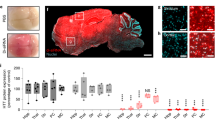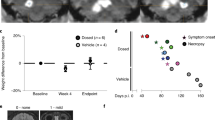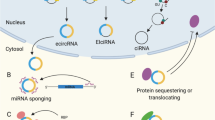Abstract
As an evolutionarily conserved cellular pathway to regulate endogenous gene expression, RNA interference (RNAi) has been implicated in diverse biological processes. Biologists now routinely exploit this cellular pathway to suppress virtually any target gene in a sequence-specific manner, including dominantly acting genes that cause incurable neurodegenerative disorders. The development of RNAi as potential therapy for such diseases has generated considerable interest, partly because of the success of early studies of therapeutic RNAi in rodent models for a range of neurodegenerative diseases. In this article, we review the progress of RNAi therapy to date, and assess the challenges ahead for the application of such therapy to neurodegenerative diseases. We discuss the various strategies that might be used to achieve this goal, outline the preclinical studies that have already been completed, and highlight the experimental questions that need to be answered before human clinical trials can begin.
Key Points
-
RNA interference (RNAi) is a naturally occurring biological pathway in which small, double-stranded RNA molecules suppress gene expression in an exquisitely sequence-specific manner
-
Exogenous manipulation of RNAi is being explored as a powerful method of silencing disease-causing genes in incurable neurological disorders
-
Preclinical trials in animal models of various neurodegenerative diseases have demonstrated the feasibility and efficacy of this approach
-
Research efforts are invested in developing viral and nonviral methods of delivering RNAi-mediating molecules to various target brain regions
-
The safety of manipulating the RNAi pathway in the brain, where it participates in synaptic function, neuronal differentiation and brain development, needs to be carefully addressed
This is a preview of subscription content, access via your institution
Access options
Subscribe to this journal
Receive 12 print issues and online access
$209.00 per year
only $17.42 per issue
Buy this article
- Purchase on Springer Link
- Instant access to full article PDF
Prices may be subject to local taxes which are calculated during checkout

Similar content being viewed by others
References
Fire A et al. (1998) Potent and specific genetic interference by double-stranded RNA in Caenorhabditis elegans. Nature 391: 806–811
Paulson H and Gonzalez-Alegre P (2006) RNAi gets its prize. Lancet Neurol 5: 997–999
Gonzalez-Alegre P (2007) Therapeutic RNA interference for neurodegenerative diseases: from promise to progress. Pharmacol Ther 114: 34–55
Davidson BL and Paulson HL (2004) Molecular medicine for the brain: silencing of disease genes with RNA interference. Lancet Neurol 3: 145–149
Rodriguez-Lebron E and Gonzalez-Alegre P (2006) Silencing neurodegenerative disease: bringing RNA interference to the clinic. Expert Rev Neurother 6: 223–233
Bartel DP (2004) MicroRNAs: genomics, biogenesis, mechanism, and function. Cell 116: 281–297
Carmell MA and Hannon GJ (2004) RNase III enzymes and the initiation of gene silencing. Nat Struct Mol Biol 11: 214–218
Cullen BR (2004) Transcription and processing of human microRNA precursors. Mol Cell 16: 861–865
Du T and Zamore PD (2005) microPrimer: the biogenesis and function of microRNA. Development 132: 4645–4652
Kim VN (2005) MicroRNA biogenesis: coordinated cropping and dicing. Nat Rev Mol Cell Biol 6: 376–385
Meister G and Tuschl T (2004) Mechanisms of gene silencing by double-stranded RNA. Nature 431: 343–349
Murchison EP and Hannon GJ (2004) miRNAs on the move: miRNA biogenesis and the RNAi machinery. Curr Opin Cell Biol 16: 223–229
Tomari Y and Zamore PD (2005) Perspective: machines for RNAi. Genes Dev 19: 517–529
Tomari Y and Zamore PD (2005) MicroRNA biogenesis: drosha can't cut it without a partner. Curr Biol 15: R61–R64
Meister G et al. (2004) Human Argonaute2 mediates RNA cleavage targeted by miRNAs and siRNAs. Mol Cell 15: 185–197
Miller VM et al. (2005) RNA interference in neuroscience: progress and challenges. Cell Mol Neurobiol 25: 1195–1207
Gunsalus KC and Piano F (2005) RNAi as a tool to study cell biology: building the genome–phenome bridge. Curr Opin Cell Biol 17: 3–8
Dykxhoorn DM and Lieberman J (2005) The silent revolution: RNA interference as basic biology, research tool, and therapeutic. Annu Rev Med 56: 401–423
Bentwich I et al. (2005) Identification of hundreds of conserved and nonconserved human microRNAs. Nat Genet 37: 766–770
Berezikov E et al. (2005) Phylogenetic shadowing and computational identification of human microRNA genes. Cell 120: 21–24
Xie X et al. (2005) Systematic discovery of regulatory motifs in human promoters and 3[prime] UTRs by comparison of several mammals. Nature 434: 338–345
Lim LP et al. (2005) Microarray analysis shows that some microRNAs downregulate large numbers of target mRNAs. Nature 433: 769–773
Jackson RJ and Standart N (2007) How do microRNAs regulate gene expression? Sci STKE 2007: re1
Liu J et al. (2005) MicroRNA-dependent localization of targeted mRNAs to mammalian P-bodies. Nat Cell Biol 7: 719–723
Kosik KS (2006) The neuronal microRNA system. Nat Rev Neurosci 7: 911–920
Giraldez AJ et al. (2005) MicroRNAs regulate brain morphogenesis in zebrafish. Science 308: 833–838
Jin P et al. (2004) RNA and microRNAs in fragile X mental retardation. Nat Cell Biol 6: 1048–1053
Bumcrot D et al. (2006) RNAi therapeutics: a potential new class of pharmaceutical drugs. Nat Chem Biol 2: 711–719
Shankar P et al. (2005) The prospect of silencing disease using RNA interference. JAMA 293: 1367–1373
Kim DH and Rossi JJ (2007) Strategies for silencing human disease using RNA interference. Nat Rev Genet 8: 173–184
Izquierdo M (2005) Short interfering RNAs as a tool for cancer gene therapy. Cancer Gene Ther 12: 217–227
Ketzinel-Gilad M et al. (2006) RNA interference for antiviral therapy. J Gene Med 8: 933–950
Paulson HL (2000) Toward an understanding of polyglutamine neurodegeneration. Brain Pathol 10: 293–299
Paulson HL et al. (2000) Polyglutamine disease and neuronal cell death. Proc Natl Acad Sci USA 97: 12957–12958
Gonzalez-Alegre P and Paulson HL (2004) Aberrant cellular behavior of mutant torsinA implicates nuclear envelope dysfunction in DYT1 dystonia. J Neurosci 24: 2593–2601
Goodchild RE and Dauer WT (2004) Mislocalization to the nuclear envelope: an effect of the dystonia-causing torsinA mutation. Proc Natl Acad Sci USA 101: 847–852
Rodriguez-Lebron E and Paulson HL (2006) Allele-specific RNA interference for neurological disease. Gene Ther 13: 576–581
Gonzalez-Alegre P et al. (2003) Toward therapy for DYT1 dystonia: allele-specific silencing of mutant TorsinA. Ann Neurol 53: 781–787
Gonzalez-Alegre P et al. (2005) Silencing primary dystonia: lentiviral-mediated RNA interference therapy for DYT1 dystonia. J Neurosci 25: 10502–10509
Miller VM et al. (2003) Allele-specific silencing of dominant disease genes. Proc Natl Acad Sci USA 100: 7195–7200
Schwarz DS et al. (2006) Designing siRNA that distinguish between genes that differ by a single nucleotide. PLoS Genet 2: e140
Marcotte L and Crino PB (2006) The neurobiology of the tuberous sclerosis complex. Neuromolecular Med 8: 531–546
Singleton AB et al. (2003) α-Synuclein locus triplication causes Parkinson's disease. Science 302: 841
Paulson H and Ammache Z (2001) Ataxia and hereditary disorders. Neurol Clin 19: 759–782, viii
Humbert S and Saudou F (2002) Toward cell specificity in SCA1. Neuron 34: 669–670
Matilla A et al. (1998) Mice lacking ataxin-1 display learning deficits and decreased hippocampal paired-pulse facilitation. J Neurosci 18: 5508–5516
Zu T et al. (2004) Recovery from polyglutamine-induced neurodegeneration in conditional SCA1 transgenic mice. J Neurosci 24: 8853–8861
Xia H et al. (2004) RNAi suppresses polyglutamine-induced neurodegeneration in a model of spinocerebellar ataxia. Nat Med 10: 816–820
Ralph GS et al. (2005) Silencing mutant SOD1 using RNAi protects against neurodegeneration and extends survival in an ALS model. Nat Med 11: 429–433
Raoul C et al. (2005) Lentiviral-mediated silencing of SOD1 through RNA interference retards disease onset and progression in a mouse model of ALS. Nat Med 11: 423–428
Saito Y et al. (2005) Transgenic small interfering RNA halts amyotrophic lateral sclerosis in a mouse model. J Biol Chem 280: 42826–42830
Xia X et al. (2006) Allele-specific RNAi selectively silences mutant SOD1 and achieves significant therapeutic benefit in vivo. Neurobiol Dis 23: 578–586
Sapru MK et al. (2006) Silencing of human α-synuclein in vitro and in rat brain using lentiviral-mediated RNAi. Exp Neurol 198: 382–390
Harper SQ et al. (2005) RNA interference improves motor and neuropathological abnormalities in a Huntington's disease mouse model. Proc Natl Acad Sci USA 102: 5820–5825
Rodriguez-Lebron E et al. (2005) Intrastriatal rAAV-mediated delivery of anti-huntingtin shRNAs induces partial reversal of disease progression in R6/1 Huntington's disease transgenic mice. Mol Ther 12: 618–633
Machida Y et al. (2006) rAAV-mediated shRNA ameliorated neuropathology in Huntington disease model mouse. Biochem Biophys Res Commun 343: 190–197
Wang YL et al. (2005) Clinico-pathological rescue of a model mouse of Huntington's disease by siRNA. Neurosci Res 53: 241–249
Singer O et al. (2005) Targeting BACE1 with siRNAs ameliorates Alzheimer disease neuropathology in a transgenic model. Nat Neurosci 8: 1343–1349
Hong CS et al. (2006) Herpes simplex virus RNAi and neprilysin gene transfer vectors reduce accumulation of Alzheimer's disease-related amyloid-β peptide in vivo. Gene Ther 13: 1068–1079
Pfeifer A et al. (2006) Lentivector-mediated RNAi efficiently suppresses prion protein and prolongs survival of scrapie-infected mice. J Clin Invest 116: 3204–3210
Davidson BL and Breakefield XO (2003) Viral vectors for gene delivery to the nervous system. Nat Rev Neurosci 4: 353–364
Fountaine TM et al. (2005) Delivering RNA interference to the mammalian brain. Curr Gene Ther 5: 399–410
Sah DW (2006) Therapeutic potential of RNA interference for neurological disorders. Life Sci 79: 1773–1780
Grimm D et al. (2006) Fatality in mice due to oversaturation of cellular microRNA/short hairpin RNA pathways. Nature 441: 537–541
Alvarez VA et al. (2006) Retraction of synapses and dendritic spines induced by off-target effects of RNA interference. J Neurosci 26: 7820–7825
Stark GR et al. (1998) How cells respond to interferons. Annu Rev Biochem 67: 227–264
Bridge AJ et al. (2003) Induction of an interferon response by RNAi vectors in mammalian cells. Nat Genet 34: 263–264
Jackson AL et al. (2006) Widespread siRNA “off-target” transcript silencing mediated by seed region sequence complementarity. RNA 12: 1179–1187
Judge AD et al. (2005) Sequence-dependent stimulation of the mammalian innate immune response by synthetic siRNA. Nat Biotechnol 23: 457–462
Pebernard S and Iggo RD (2004) Determinants of interferon-stimulated gene induction by RNAi vectors. Differentiation 72: 103–111
Sledz CA et al. (2003) Activation of the interferon system by short-interfering RNAs. Nat Cell Biol 5: 834–839
Heidel JD et al. (2004) Lack of interferon response in animals to naked siRNAs. Nat Biotechnol 22: 1579–1582
Birmingham A et al. (2006) 3′ UTR seed matches, but not overall identity, are associated with RNAi off-targets. Nat Methods 3: 199–204
Qiu S et al. (2005) A computational study of off-target effects of RNA interference. Nucleic Acids Res 33: 1834–1847
Khvorova A et al. (2003) Functional siRNAs and miRNAs exhibit strand bias. Cell 115: 209–216
Schwarz DS et al. (2003) Asymmetry in the assembly of the RNAi enzyme complex. Cell 115: 199–208
Zeng Y et al. (2003) MicroRNAs and small interfering RNAs can inhibit mRNA expression by similar mechanisms. Proc Natl Acad Sci USA 100: 9779–9784
Miller N and Whelan J (1997) Progress in transcriptionally targeted and regulatable vectors for genetic therapy. Hum Gene Ther 8: 803–815
Acknowledgements
Work on RNA interference in the authors' laboratories has been funded by grants from American Federation for Aging Research (HLP), Dystonia Medical Research Foundation (PG) and NIH (PO1 NS050210, directed by Beverly Davidson, University of Iowa).
Author information
Authors and Affiliations
Corresponding author
Ethics declarations
Competing interests
HL Paulson has received honoraria from Athena Diagnostics and has acted as a consultant for Sirna Therapeutics. P Gonzalez-Alegre declared he has no competing interests.
Rights and permissions
About this article
Cite this article
Gonzalez-Alegre, P., Paulson, H. Technology Insight: therapeutic RNA interference—how far from the neurology clinic?. Nat Rev Neurol 3, 394–404 (2007). https://doi.org/10.1038/ncpneuro0551
Received:
Accepted:
Issue Date:
DOI: https://doi.org/10.1038/ncpneuro0551
This article is cited by
-
PolyMetformin combines carrier and anticancer activities for in vivo siRNA delivery
Nature Communications (2016)
-
Lethal toxicity caused by expression of shRNA in the mouse striatum: implications for therapeutic design
Gene Therapy (2011)
-
RNAi: a potential new class of therapeutic for human genetic disease
Human Genetics (2011)



